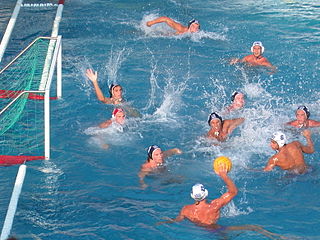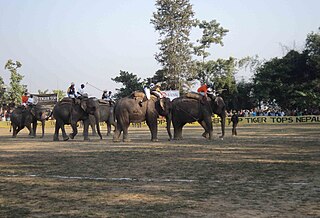
Polo is a horseback ball game, a traditional field sport and one of the world's oldest known team sports. The game is played by two opposing teams with the objective of scoring using a long-handled wooden mallet to hit a small hard ball through the opposing team's goal. Each team has four mounted riders, and the game usually lasts one to two hours, divided into periods called chukkas or "chukkers".

Gaelic football, commonly known as simply Gaelic, GAA or Caid, is an Irish team sport. It is played between two teams of 15 players on a rectangular grass pitch. The objective of the sport is to score by kicking or punching the ball into the other team's goals or between two upright posts above the goals and over a crossbar 2.5 metres above the ground.

Water polo is a competitive team sport played in water between two teams of seven players each. The game consists of four quarters in which the two teams attempt to score goals by throwing the ball into the opposing team's goal. The team with the most goals at the end of the game wins the match. Each team is made up of six field players and one goalkeeper. Excluding the goalkeeper, players participate in both offensive and defensive roles. Water polo is typically played in an all-deep pool so that players cannot touch the bottom.

International rules football is a team sport consisting of a hybrid of football codes, which was developed to facilitate international representative matches between Australian rules football players and Gaelic football players.
The Laws of the Game (LOTG) are the codified rules of association football. The laws mention the number of players a team should have, the game length, the size of the field and ball, the type and nature of fouls that referees may penalize, the offside law, and many other laws that define the sport. During a match, it is the task of the referee to interpret and enforce the Laws of the Game.

Polocrosse is a team sport that is a combination of polo and lacrosse. It is played outside, on a field, on horseback. Each rider uses a cane or fibreglass stick to which is attached a racquet head with a loose, thread net, in which the ball is carried. The ball is made of sponge rubber and is approximately four inches across. The objective is to score goals by throwing the ball between the opposing team's goal posts.

Cycle polo is a team sport, similar to traditional polo, except that bicycles are used instead of horses. There are two versions of the sport: grass and Hardcourt Bike Polo. The hardcourt game saw a sharp spike in interest in the first decade of the 21st century and new teams are sprouting up across the world in China, Canada, Ireland, Switzerland, France, India, Germany, Pakistan, Ukraine, Russia, Malaysia, Sri Lanka, Indonesia, Hungary, Australia, New Zealand, Sweden, England, Scotland, Argentina, Italy, Spain, USA, Poland, Croatia, Slovenia, Lithuania, Nepal, Brazil and Cuba.

The laws of Australian rules football were first created by the Melbourne Football Club in 1859 and have been refined over the years as the sport evolved into its modern form. The laws significantly predate the advent of a governing body for the sport. The first national and international body, the Australasian Football Council (AFC), was formed in 1905 and became responsible for the laws, although individual leagues retained a wide discretion to vary them. Since 1994, after the establishment of a nation-wide Australian Football League (AFL), the rules for the game have been maintained by the AFL Commission through its AFL Competition Committee.

An umpire is an official in the sport of Australian rules football who adjudicates the game according to the "Laws Of The Game", the official handbook of Australian Rules Football.

Segway polo is a team sport which started to gain some measure of popularity after being played by members of the Bay Area Segway Enthusiasts Group in 2004. The Bay Area SEG was not the first to play polo on a Segway HT; a team sponsored by Mobile Entertainment played in the Hubert H. Humphrey Metrodome at a Minnesota Vikings halftime show in 2003 although the Bay Area SEG members were not aware of this match at the time they first played the sport. Segway polo was developed as it is played today by the members of the Bay Area SEG and other groups and teams that have joined subsequently.
The Federation of International Polo is the international federation representing the sport of polo, officially recognized by the International Olympic Committee. It was founded in 1982 by representatives of eleven national polo associations, and currently represents the national polo associations of more than 90 countries. FIPs principal aim is to enhance the image and status of the great game of polo internationally.

Hardcourt Bike Polo is a variation of traditional Bicycle Polo in which teams of players ride bicycles and use mallets to strike a small ball into a goal. It may also be referred to as "Hardcourt", "Urban Bike Polo" or simply "Bike Polo".

Elephant polo is a variant of polo played while riding elephants. It is played in Nepal, Rajasthan (India), and Thailand. England and Scotland regularly field teams. Equipment consists of a standard polo ball and six to ten foot cane sticks with a polo mallet head on the end. The pitch is three-quarters of the length of a standard polo pitch, due to the lower speed of the elephants. Two people ride each elephant; the elephants are steered by mahouts, while the player tells the mahout which way to go and hits the ball.
The 19th DSB Congress, comprising several tournaments, began on 20 July 1914 in Mannheim. Germany declared war on Russia and on France, Britain joining in the next day. The congress was stopped on 1 August 1914.
Cowboy polo is a variation of polo played mostly in the western United States. Like regular polo, it is played in chukkas (periods) with two teams on horses who use mallets to hit a ball through a goal. It differs from traditional polo in that five riders make up a team instead of four, western saddles and equipment are used, and the playing field is usually a simple rodeo arena or other enclosed dirt area, indoors or out. Also, instead of the small ball used in traditional polo, the players use a large red rubber medicine ball and use mallets with long fiberglass shafts and hard rubber heads.
Arena polo is a fast-paced version of polo played outdoors on an enclosed all-weather surface, or in an indoor arena. Hurlingham Polo Association and US Polo Association have established their own rules for arena polo, and these rules are often used in other countries as well.
Rege Ludwig is a polo instructor and high-goal coach who has been playing and instructing polo for over 30 years.

A hobby horse is a child's toy horse. Children played at riding a wooden hobby horse made of a straight stick with a small horse's head, and perhaps reins, attached to one end. The bottom end of the stick sometimes had a small wheel or wheels attached. This toy was also sometimes known as a cock horse or stick horse.

India is the birthplace of modern polo. The modern game of polo is derived from Manipur, where the game was known as 'Sagol Kangjei', 'Kanjai-bazee', or 'Pulu'. It was the anglicised form of the last, referring to the wooden ball that was used, which was adopted by the sport in its slow spread to the west.

Automobile polo or auto polo was a motorsport invented in the United States with rules and equipment similar to equestrian polo but using automobiles instead of horses. The sport was popular at fairs, exhibitions and sports venues across the United States and several areas in Europe from 1911 until the late 1920s; it was, however, dangerous and carried the risk of injury and death to the participants and spectators, and expensive damage to vehicles.














